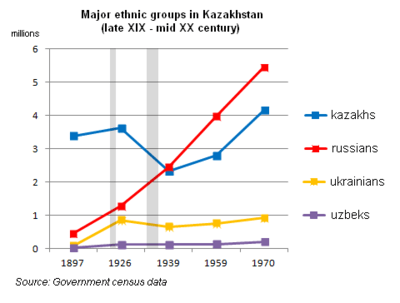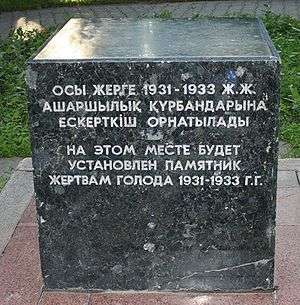Kazakhstan famine of 1932-1933

The Kazakhstan famine of 1932–1933, described as Kazakh catastrophe by Robert Conquest,[1] was part of the Soviet famine of 1932–33. While Ukraine was worst affected, the famine also spread to the Russian Soviet Federative Socialist Republic's autonomous republic, Kazakhstan and other areas.[2] Kazakhs were most severely affected by the Soviet famine in terms of percentage of people who died (approximately 38%).[3] Around 1.5 million (or possibly as many as 2.0–2.3 million) people died in Kazakhstan of whom 1.3 million were ethnic Kazakhs.[4]
It is known in Kazakshan as "Goloshchekin genocide" (Kazakh: Голощекиндік геноцид),[5] in reference to Filipp Goloshchyokin, who carried out the Sovietization of Kazakhstan at the time.
Taking into an account the Kazakh famine of 1919–1922, in 10–15 years Kazakh lands lost more than half of its population due to the actions of the Soviet power.[6]
Consequences

The famine made Kazakhs a minority in their own republic, and not until the 1990s did Kazakhs become the largest group in Kazakhstan again. Before the famine, around 60% of the republic's population where Kazakhs, but after the famine, only around 38% of the population were Kazakhs.[7][5][8][9]
See also
Further reading
- Conquest, Robert, «The Harvest of Sorrow: Soviet Collectivization and the Terror — Famine», (Edmonton: The University of Alberta Press in Association with the Canadian Institute of Ukrainian Studies, 1986).
- Sahni, Kalpana. Crucifying the Orient : Russian orientalism and the colonization of Caucasus and Central Asia. Bangkok : White Orchid Press, 1997
- I. Ohayon, La sédentarisation des Kazakhs dans l’URSS de Staline, collectivisation et changement social, Paris, maisonneuve et Larose, 2006 (French)
References
- ↑ Robert Conquest, The Harvest of Sorrow: Soviet Collectivization and the Terror-famine, 1987
- ↑ Pannier, Bruce (2007-12-28). "Kazakhstan: The Forgotten Famine". Rferl.org. Retrieved 2015-07-09.
- ↑ NICCOLÒ PIANCIOLA (2001). "The Collectivization Famine in Kazakhstan, 1931–1933". Harvard Ukrainian Studies. Harvard Ukrainian Research Institute. 25 (3–4): 237–251. JSTOR 41036834. PMID 20034146.
- ↑ Volkava, Elena (2012-03-26). "The Kazakh Famine of 1930–33 and the Politics of History in the Post-Soviet Space". Wilson Center. Retrieved 2015-07-09.
- 1 2 Қазақстан тарихы: Аса маңызды кезеңдері мен ғылыми мәселелері. Жалпы білім беретін мектептің қоғамдык- гуманитарлық бағытындағы 11-сыныбына арналған оқулық / М.Қойгелдиев, Ә.Төлеубаев, Ж.Қасымбаев, т.б. — Алматы: «Мектеп» баспасы, 2007. — 304 бет,суретті. ISBN 9965-36-106-1
- ↑ "Во время голода в Казахстане погибло 40 процентов населения".
- ↑ Татимов М. Б. Социальная обусловленность демографических процессов. Алма-Ата,1989. С.124
- ↑ http://world.lib.ru/p/professor_l_k/070102_koval_drujba.shtml - "Запомнил и долю казахов в пределах своей республики - 28%. А за тридцать лет до того они составляли у себя дома уверенное большинство"
- ↑ PIANCIOLA, NICCOLÒ (1 January 2001). "The Collectivization Famine in Kazakhstan, 1931–1933". Harvard Ukrainian Studies. 25 (3/4): 237–251. doi:10.2307/41036834 (inactive 2016-08-25). JSTOR 41036834.